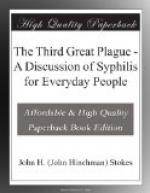+Scientific Methods of Treating Disease.+—In trying to treat diseases caused by germs, the physician finds himself confronted by several different problems. Certain of these diseases run their course and the patient gets well or dies, pretty much regardless of anything that can be done for him. In certain others, because of our knowledge of the way in which the body makes its fight against the germ, we are able either to prepare it against attack, as in the case of protective vaccination, or we are able to help it to come to its own defense after the disease has developed. This can be done either by supplying it with antitoxin from an outside source, or helping it to make its own antitoxin by giving it dead germs to practise on. In the third group, the smallest of the three, we are fortunate enough to know of some substance which will kill the germ in the body without killing the patient. For such diseases we are said to have a “specific” method of treatment. Syphilis is one of these diseases. It is not to be understood that there is a sharp line of division between these three groups, since in every disease we try as far as possible to use all the methods we can bring to bear. In pneumonia we have to let the body largely make its own fight, and simply help it to clear out the poisons formed by the germ, and keep the heart going until the crisis is past. In diphtheria, nowadays, we help the body out promptly by supplying it with antitoxin from an outside source, before it has time to make any for itself. We do the same thing for lockjaw if we are early enough. We practise the body on dead typhoid germs by vaccination until it is able to fight the living ones and destroy them before they get a foothold. The diseases for which we have specific methods of treatment are few in number, and each has associated with it the name of a particular drug. Quinin kills the germ of malaria, sodium salicylate cures inflammatory rheumatism, and mercury cures syphilis. To mercury in the case of syphilis must now be added salvarsan or arsenobenzol ("606"), the substance devised by Ehrlich in 1910, which will be considered in the next chapter.
The action of a specific is, of course, not infallible, but the failures are exceptional, so that one feels in attacking one of these diseases with its specific remedy as a man called upon to resist a savage beast would feel if he were armed with a powerful rifle instead of a stick. The situation in syphilis, for which there is a specific, as compared with tuberculosis, for which there is no specific, is incomparably in favor of the former. If we had as powerful weapons against tuberculosis as we have against syphilis, the disease would now be a rarity instead of the disastrous plague it is. Comparing the situation in two diseases for which we have specifics, such as syphilis and malaria, malaria has lost most of its seriousness as a problem in any part of the world, while syphilis is rampant everywhere. Malaria has, of course, been extinguished




